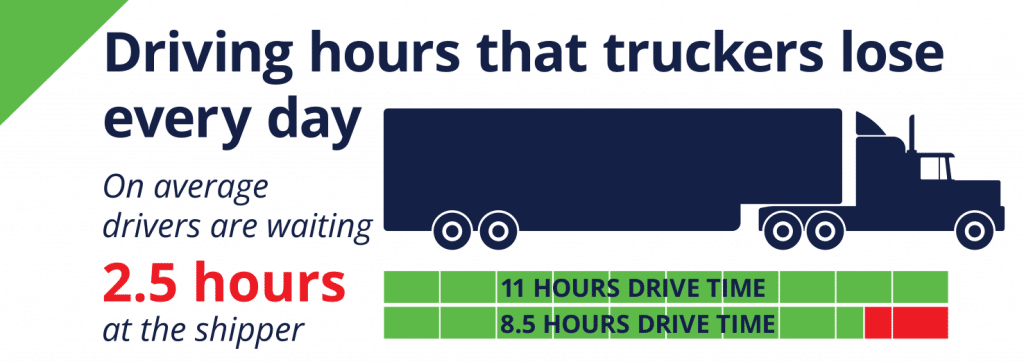How trucker detention time affects your business’ profits
Find out how detention time is limiting your profits and what you can do to save your fleet's driving hours every week.

You’ve probably been in this situation before.
You plan your loads a week ahead of time, calculating your profits and miles expecting to make a good profit.
But once your driver arrives at their first drop-off destination of the week, they get stuck waiting.
So they wait for an hour, then two, then three, and still no movement.
Now, they’re most likely going to be delayed for their drop-off and you’ve got to reschedule their entire week.
We know that your trucking business is constantly running on a tight schedule, and dealing with delays that are out of your control is having a major effect on your business–wasting your time and money.
We’re talking about potentially tens of thousands of dollars being lost annually for your business.
So, let’s take a closer look at what detention time is, what it’s costing your trucking business, and what you can do to deal with it.
What is trucker detention time?
Detention time is the time your driver spends waiting at the shipper/receiver to be loaded or unloaded.
Currently, your fleet is spending close to 2.5 hours waiting at a shipper or receiver’s yard according to Business Insider.
However, detention times can vary greatly–from 30 minutes to 6 hours according to a 2018 report from the American Transportation Research Institute (ATRI) looking at the effects of detention time in the industry.

The ATRI also found that there’s been an over 27% increase in shipper/receiver delays of six or more hours since 2014.
These increases have been a cause for concern throughout the industry–leading to losses in weekly revenue for fleets like yours.
Nearly 69% of carriers and 78% of drivers who responded to the survey indicated that customer delays had a “moderate or significant” impact on their revenue every week
And in addition to the length of time spent waiting at the shipper, the ATRI also looked at the frequency in which instances of detention time are occurring.
They found that more than 70 percent of their respondents had pick-ups and deliveries that were delayed specifically because of customer actions—including keeping drivers waiting for excessive periods of time.
So not only are detention times increasing in length, but they’re also becoming more and more common–costing your business thousands of dollars in profits.
How much money is detention time costing me?

Your fleet is potentially losing tens of thousands of dollars caused by hours-long delays at the shipper and receivers.
In fact, according to the ATRI report, excessive detention times cost drivers and motor carriers like yourself $1 billion collectively every year.
Let’s do some quick math.
Let’s say you’ve got 4 over-the-road trucks in your fleet and they’re each averaging about 2 loads a week. For both of these loads, they’ll be forced to wait 2.5 hours at their pick-up and drop-off locations.
At 2 loads a week, they’ll spend a total of 10 hours just waiting around.
When you consider all 4 of your trucks, your business is losing 40 hours of driving time on average every week.
Just imagine how much more money your business could be making if your drivers could actually spend their time driving rather than waiting for a load to be ready.
It can add up to tens of thousands of dollars in profits for your fleet–especially when you consider how many more loads you may be able to book if your driver’s time was freed up.
How long can a shipper/receiver detain a truck?

While there is no required amount of time, shippers and receivers on average will keep your drivers in detention for 2.5 hours.
However, times can also vary from 30 minutes to 6 hours according to the ATRI.
How much can I charge for detention time?

As a carrier, you can choose how much to charge and when that charge goes into effect. It’s common for carriers to charge detention fees of $50 to $100 per hour for delays over 2 hours.
This means that after the initial 2 hours of detention time, you can begin to charge the shipper or receiver the detention fee of your choosing.
While 2 hours is standard, the time billed can also start after 1 hour or even after 6 hours. In the end, it’ll heavily depend on the terms you negotiate.
Detention fees can be an effective way to incentivize shippers/receivers to load you faster in some cases, but they’re not a full-proof plan. Here’s why:
- They can make it difficult for you to receive your payment, requiring constant phone calls to brokers.
- They may only offer to partially pay what you’re owed
- They may not even pay you altogether
According to the ATRI report, only 29.3% of carriers reported that they collected all the detention fees they had billed to customers.
And while these fees can help you recuperate a fraction of the money you’re losing–it doesn’t even come close to covering your operating costs, your driver’s lost wages, and the potential driving hours that were lost in the process.
In the end, you’re losing a substantial amount of time and money waiting at the shipper/receiver, even if you collect detention fees.
How do I avoid detention?
As long as your driver is not needed at the dock and they know that a 2-to 3-hour wait is incoming, they can switch their status to off-duty and begin a split-sleeper berth.
The Federal Motor Carrier Safety Administration (FMCSA) allows for drivers to split their sleeper berth two ways:
- A 7/3 or 3/7 split
- and a 8/2 or 2/8 split
This will help you and your drivers avoid all the issues that come with detention, primarily the loss of income.
How so?
Since your drivers aren’t logging any on-duty hours throughout the 2 to 3 hour period, they’re saving their driving and on-duty time–helping them drive more miles and make more money every week.
However, if a driver is in the process of being loaded or unloaded, they must remain on duty and should not switch to off-duty or sleeper berth throughout this period.
So, how would you go about using a split-sleeper berth?
It’s easy when you sign up with GPSTab!
With our ELD, you can use our Split-Sleeper feature to save your hours of service for the road, rather than wasting them at the shipper.
Unlike other providers that make it a hassle to use, our Split-Sleeper feature is readily available to you when you need it. You can also use our “SSB” clocks to keep your drivers and dispatchers aware of their hours of service.
Our clocks will give you additional insight into how many hours you’ll have remaining on any given day if you were to use a split-sleeper berth. This helps your office and drivers plan their stops more effectively, with your profits in mind.
Want to see how it works for yourself?
Try GPSTab free for 7-days by clicking here and start driving more miles and making more money today.





